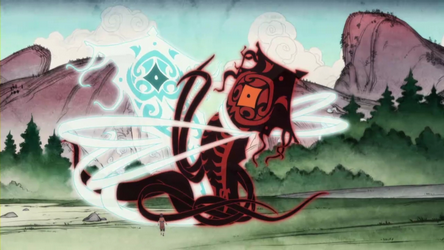Legend of Korra Book 2: Spirits Will Make Fans of The Last Airbender Feel Right at Home
Joey Sack ’17 / Emertainment Monthly Staff

As the title suggests, Book Two: Spirits revolves around Avatar Korra’s (Janet Varney) connection to the Spirit World and as the bridge between humans and spirits. It’s been six months since Korra defeated the Equalist leader Amon (Steve Blum), and Korra has mastered airbending. Tenzin (J.K. Simmons), however, sees that she has yet to master the spiritual side of being the Avatar–which is odd, seeing as she gained control of the Avatar State, a very spiritually-powered ability, in the first season finale, and that makes her a fully realized Avatar–and hopes that the family vacation to the Air Temples will give her the inspiration she needs. While visiting her home in the Southern Water Tribe, Korra runs into some Dark Spirits and decides to learn from her uncle Chief Unalaq (Adrian LaTourelle), of the Northern Water Tribe, how to maintain balance with the spirits. Over the course of the season, the story is split between Korra, Tenzin’s family, Unalaq and his twin children, Desna and Eska (Aaron Himelstein and Aubrey Plaza), and stories with Mako (David Faustino), Bolin (P.J. Byrne), and Asami (Seychelle Gabriel) in Republic City concerning Varrick (John Michael Higgins).


The first few episodes of the season, done by Studio Pierrot, looked pretty good. Given that it’s the difference between South Korean and Japanese animation teams, there is bound to be differences. In “Beginnings,” Studio Mir, went with very traditional looking backgrounds, and even the way that the elements looked was different. The backgrounds and the entirety of the episode looked like something out of a painting. As the season goes on, the animation stayed at a very crisp, clean, beautiful level, hardly ever faltering.
Related: SDCC ’13: Legend of Korra Panel
The character development was hit-and-miss for the most part, with a lot of good and also some retreading and stagnation. Korra, at the beginning of the season, seems to have reverted back to her over-confident, headstrong self from Book One, which made for some moments of déjà vu in terms of the struggles she had to endure. Although, after meeting the first Avatar and learning about what she needs to do to save the world, she does seem to become wiser and a bit more tactical. She even begins to see herself as more than just the Avatar, and see herself as Korra.
This is something that she didn’t master in Book One. Ever since she was four years old, everyone told her that she was the Avatar, and as such, was destined for greatness. When she almost lost that at the end of Book One, she is brought to the her lowest point. ,She’s only brought back from the brink by an admittedly rushed deus ex machine in Aang when he appears seemingly out of nowhere. But by the end of this season, Korra seems to have had some actual serious growth, making decisions that she may not have made earlier due to self doubt or the counsel of others. We just have to hope that her development carries over into the next season.


Some of the moments between Tenzin and his siblings stir up old feelings about the original series when you realize that these people are the children of Team Avatar. Tenzin’s children, Jinora (Kiernan Shipka), Ikki (Darcy Rose Byrnes), and Meelo (Logan Wells), have also grown up and matured since the first season, while still retaining that childhood wonder and energy that reminds viewers of their grandfather, Aang.

Overall, this season of The Legend of Korra was a vast improvement over Book One, and will make longtime fans of Avatar feel right at home. It faltered at times, and went over some old ground, but it also went to places we weren’t expecting. It made us laugh, cry,remember what it is about this story, this world, and this mythology that keeps audiences coming back for more.
The season finale is an epic, heart pounding, nail biting thrill ride, but if you haven’t seen the rest of the season, don’t go into the finale lost. Go back and watch the first 12 episodes of the season to catch up, or watch Book One: Air if you haven’t already. The season finale of The Legend of Korra will air on Nickelodeon on November 22nd at 8PM EST, so tune in to see the conclusion of a story fit for Avatar: The Last Airbender, the series that started it all.
[polldaddy poll=7568088]
what show are you watching? it cant be korra, otherwise youve never even actually watched the last airbender if you are comparing the two